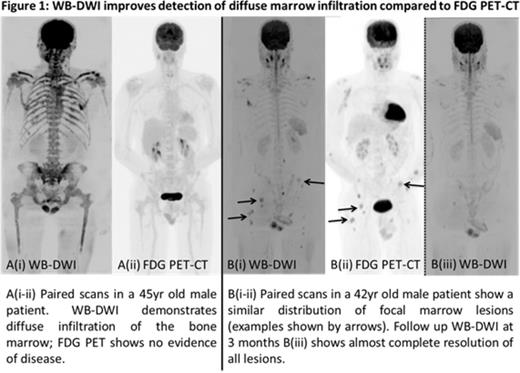Abstract

Introduction:
Whole body MRI is recommended for all patients suspected of having smouldering myeloma for detection of disease defining lesions (Dimopoulos et al. 2015). The speed, sensitivity and quantitative capabilities of Whole body Diffusion Weighted MRI (WB-DWI) have seen this increasingly used as the MRI sequence of choice for detection and response assessment in myeloma (Messiou and Kaiser 2015). 18-F-fluorodeoxyglucose positron emission tomography-CT (FDG PET-CT) also offers whole body coverage with standard uptake value (SUV) measurements of individual lesions. In previous studies the sensitivity and specificity of conventional MRI superseded FDG PET-CT due to improved detection of small focal lesions and diffuse disease (Zamagni et al. 2007, Shortt et al. 2009). However, WB-DWI and FDG PET-CT comparisons in patients with myeloma have not previously been investigated. We compared the assessment of myeloma using these two modalities and determined the relationship to laboratory estimates of disease burden.
Method:
Patients who had undergone paired WB-DWI and FDG PET-CT scans for myeloma at our institution were included. Scans were excluded if there was clinical or biochemical evidence of change in disease status between scans. Expert radiologists (WB-DWI = CM, AR; FDG PET-CT = BS, LF) scored disease burden by consensus using a previously described system (Giles et al. 2014) based on the number, size and pattern (diffuse/focal) of disease. Whole body and per region scores were compared. Bone marrow trephine assessments of % plasma cell (PC) infiltration were correlated to the imaging scores and compared to the assessment of disease infiltration at the iliac crests.
Results:
20 pairs of scans were performed in 17 patients. Scans took place within a median of 9.5 days (range 0-78), mean 14 days ±18.15. There was a positive correlation between WB-DWI and FDG PET-CT scores (Spearman r = 0.35, 95% C.I. [-0.12,0.69]) but the whole body score for WB-DWI was significantly higher than for FDG PET-CT (WB-DWI mean 17.65±12.24 vs FDG PET-CT mean 8.45±8.70. P=0.0023 Wilcoxon signed rank). In all regions scores for WB-DWI (Table 1) were higher than FDG PET-CT with statistical significance in all except for pelvis and long bones.
Diffuse disease was reported in 36% (51/140) of regions on WB-DWI scans compared to only 7% (10/140) on FDG PET-CT. The regions reported as having diffuse disease on WB-DWI were reported on FDG PET-CT as 'no disease' for most (36/51) regions (Figure 1A). Whole body scores were reanalyzed including only focal lesions. The scores for FDG PET-CT and WB-DWI were no longer significantly different (FDG PET-CT mean 6.45±7.06, WB-DWI mean 7.45±10.32, P=0.92) (Figure 1Bi-ii) suggesting the ability of WB-DWI to detect more disease is largely due to the increased ability to detect diffuse marrow involvement.
For 10 WB-DWI scans on which there was activity a follow up WB-DWI was available and demonstrated a change in disease burden (e.g. Figure 1B). This supports the presence of active lesions on the initial MRI and indicates the utility of WB-DWI as a response assessment tool.
15/20 pairs had bone marrow trephines with adequate tissue for the calculation of PC % performed close to the FDG PET-CT and WB-DWI scans. The PC % was better correlated to WB-DWI scores than FDG PET-CT. In 93% of patients the trephine PC % was similar to the WB-DWI report of activity at the iliac crests compared with only 67% for FDG PET-CT.
Conclusions:
In paired scans WB-DWI reports a higher burden of myeloma disease than FDG PET-CT. This is largely due to the increased ability for WB-DWI to detect diffuse marrow disease. WB-DWI also outperforms FDG PET-CT in the assessment of disease infiltration in the iliac bones, essential for good clinical correlation of trephine results. We are in the process of validating these results in a prospective study but our results support guidance that MRI should be the investigation of choice for detection of myeloma marrow infiltration.
| Region . | Score Mean (±SD) . | P value* . | |
|---|---|---|---|
| FDG PET-CT | WB-DWI | ||
| Whole body | 8.45 (±8.70) | 17.65 (±12.24) | 0.002 |
| C spine | 0.47 (±1.17) | 1.68 (±1.92) | 0.016 |
| D spine | 1.20 (±1.64) | 2.60 (±2.04) | 0.011 |
| L spine | 1.00 (±1.62) | 2.50 (±2.04) | 0.007 |
| Pelvis | 2.40 (±2.54) | 3.30 (±1.95) | NS, 0.13 |
| Long bones | 1.85 (±2.35) | 2.80 (±2.71) | NS, 0.19 |
| Skull | 0.21 (±0.63) | 1.95 (±1.96) | 0.004 |
| Ribs/other | 1.35 (±1.90) | 3.00 (±1.97) | 0.006 |
| Region . | Score Mean (±SD) . | P value* . | |
|---|---|---|---|
| FDG PET-CT | WB-DWI | ||
| Whole body | 8.45 (±8.70) | 17.65 (±12.24) | 0.002 |
| C spine | 0.47 (±1.17) | 1.68 (±1.92) | 0.016 |
| D spine | 1.20 (±1.64) | 2.60 (±2.04) | 0.011 |
| L spine | 1.00 (±1.62) | 2.50 (±2.04) | 0.007 |
| Pelvis | 2.40 (±2.54) | 3.30 (±1.95) | NS, 0.13 |
| Long bones | 1.85 (±2.35) | 2.80 (±2.71) | NS, 0.19 |
| Skull | 0.21 (±0.63) | 1.95 (±1.96) | 0.004 |
| Ribs/other | 1.35 (±1.90) | 3.00 (±1.97) | 0.006 |
*Wilcoxon matched-pairs signed rank test
Pawlyn:Celgene: Honoraria, Other: Travel support; The Institute of Cancer Research: Employment. Off Label Use: vorinostat for treatment of myeloma. Kaiser:Amgen: Consultancy, Honoraria; Janssen: Honoraria; Chugai: Consultancy; BristolMyerSquibb: Consultancy; Celgene: Consultancy, Honoraria, Research Funding. Jones:Celgene: Other: Travel support, Research Funding. Davies:Takeda-Milenium: Honoraria; Celgene: Honoraria; Onyx-Amgen: Honoraria; University of Arkansas for Medical Sciences: Employment. Morgan:Bristol Myers Squibb: Honoraria, Membership on an entity's Board of Directors or advisory committees; Takeda-Millennium: Honoraria, Membership on an entity's Board of Directors or advisory committees; CancerNet: Honoraria; Weisman Institute: Honoraria; University of Arkansas for Medical Sciences: Employment; Celgene: Honoraria, Membership on an entity's Board of Directors or advisory committees, Research Funding; MMRF: Honoraria.
Author notes
Asterisk with author names denotes non-ASH members.

This icon denotes a clinically relevant abstract


